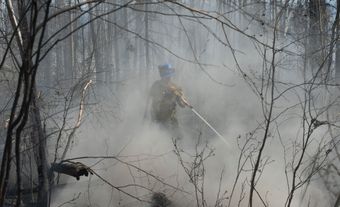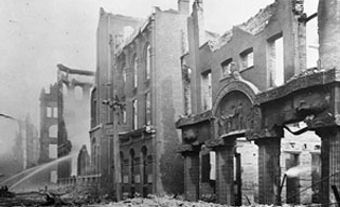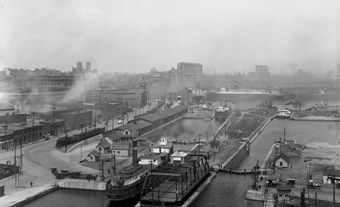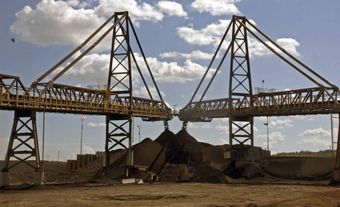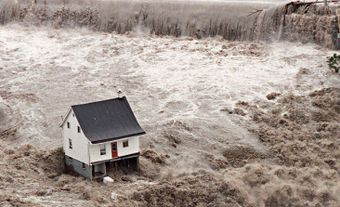On 19 April 1904, a fire swept through 20 acres of Toronto’s industrial core. By the time firefighters contained it, the blaze had destroyed at least 98 buildings. The fire incurred around $10 million in losses and left thousands unemployed. One person died in its aftermath. The disaster is known as the Great Fire of Toronto or the Second Great Fire of Toronto (the first major fire occurred in 1849). It exposed the city’s need for safer building codes and a high-pressure water system.
The Fire
Toronto’s Great Fire of 1904 started some time before 8:00 p.m. on 19 April in the city’s downtown. At the time, Toronto’s core was an industrial area with several manufacturing buildings. When firefighters reached the fire near Wellington and Bay Streets, they had trouble dousing the flames. This was because of the city’s low-pressure water system. The crew also faced strong winds. Combined with sub-zero temperatures, these winds caused the water to blow back and freeze on the firefighters.
A general alarm at 8:51 p.m. brought out all available firefighters in the city. Mayor Thomas Urquhart contacted outside communities for help. Firefighters came from cities as far away as Buffalo, Hamilton and London.
One after another, warehouses were gutted by the fire as the wind spread embers and flames from building to building. At least 23 of the businesses affected specialized in books, paper and stationery. This provided plenty of fuel for the fire. The many exposed electrical, telegraph and telephone wires made it hard for firefighters to place ladders on buildings. Water froze on the wires, causing them to fall and spark, cutting off communications.

This animation is based on a map that appeared in 1981 in Volume 17 No. 3 of the IAO Inspector, a publication of the Loss Control Engineering Department of Insurer's Advisory Organization of Canada. It formed part of an article written by R. J. Tatton, Loss Prevention Representative, Insurance Corporation of Ireland.
Thousands of curious onlookers walked or took streetcars to the fire area. Most of the downtown police force was on scene to maintain order. However, the Mail and Empire (see Globe and Mail) reported the next day that police struggled to keep back the crowds.
Citizens managed to save some buildings in the path of the fire. One example was the office of the Evening Telegram newspaper on Bay Street south of King. Protected by wet towels, staff used hand hoses and a roof hydrant to save the building. Another example was the Queen’s Hotel on Front Street, where the Royal York Hotel now stands. A cross-party group of members of provincial parliament staying there helped fight the fire. They filled bathtubs and hung wet blankets over window sashes (panels). The hotel suffered slight fire damage.
By 10:30 p.m., the entire block between Wellington and Front was ablaze. Shifting winds doubled it back north along Bay Street. By 11 p.m., the south side of Front, west of Bay, was on fire, damaging structures along the railway tracks. The high winds prevented severe damage east of Bay and north of Wellington. A sprinkler system in the Kilgour Brothers bag and box factory blocked the fire from spreading north along Yonge Street. It was one of only three buildings in the affected area to have sprinklers.

The smoldering ruins of buildings on Front Street, facing north. The Kilgour Brothers factory (with water tanks that fed its sprinkler system) can be seen in the background.
The final major battle was at a crockery warehouse on the south side of Front Street, west of Yonge. The warehouse was near the city’s customs house, which was filled with combustible goods. The fire died down after the warehouse’s wall collapsed, and the fire department declared the blaze under control at 4:30 a.m. The affected areas continued to smoulder for two weeks.
Causes
Historian Frederick H. Armstrong later proposed several causes of the fire. One was a “total neglect” of obvious safety measures. Others included hunger for profit, low spending by city officials and a lack of regulation. Downtown Toronto experienced a construction boom during the 1890s and 1900s. Buildings up to six storeys high arose during this period. But fire safety standards had not caught up. While many structures were made of brick, their interior supports were wooden, as were window trimmings. Flat roofs were covered with a combustible mix of gravel and tar. Few firewalls and sprinkler systems had been installed. Thin, unprotected glass skylights allowed fires to jump from building to building. Staircases and elevator shafts were left open.
Toronto City Council rejected attempts to create stronger construction bylaws. In his 1901 annual report, fire chief John Thompson warned about the obstacles that external wires posed to firefighting. However, the City ignored his request to have them removed. Voters, for their part, rejected a referendum in 1901 to fund a high-pressure water system.
The exact cause of the fire was never determined. Theories at the time suggested either faulty wiring or an overheated pipe from a furnace or stove.

Bay Street, west side, looking southwest from north of Wellington Street West.
Impact and Legacy
The fire affected 20 acres of the city’s core, destroying at least 98 buildings containing 220 businesses. Up to 6,000 people were left unemployed. Losses were estimated at $10 million.
A public vote in January 1905 led to the introduction of a high-pressure water system four years later. Hikes in insurance rates prompted landlords to install sprinkler systems. However, updated building codes included no provisions for burying wires. Exposed wires remained a fire hazard through the 1920s.
Canadian Bank of Commerce general manager Edmund Walker believed that the fire “was merely a halting moment in the prosperity of Toronto.” Most of the replacement buildings were made of reinforced concrete and steel. They tended to be less decorative, too. What had been a wholesaling district became part of the city’s new financial district. Many of the replacement structures were demolished during the 1960s and 1970s and replaced by office towers. The new Union Station (1930) and customs house (1935) were the last structures built in the areas cleared by the fire.
While no one was killed during the fire, one person died in its aftermath. Dynamiter John Croft set charges under the remaining wall of a building on Front Street West on 4 May 1904. When the charges didn’t go off, he went to inspect. The fuse turned out to be slow, and Croft sustained multiple injuries. He died the following morning.

 Share on Facebook
Share on Facebook Share on X
Share on X Share by Email
Share by Email Share on Google Classroom
Share on Google Classroom

